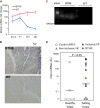The Effects of PPAR Stimulation on Cardiac Metabolic Pathways in Barth Syndrome Mice
- PMID: 29695963
- PMCID: PMC5904206
- DOI: 10.3389/fphar.2018.00318
The Effects of PPAR Stimulation on Cardiac Metabolic Pathways in Barth Syndrome Mice
Abstract
Aim: Tafazzin knockdown (TazKD) in mice is widely used to create an experimental model of Barth syndrome (BTHS) that exhibits dilated cardiomyopathy and impaired exercise capacity. Peroxisome proliferator-activated receptors (PPARs) are a group of nuclear receptor proteins that play essential roles as transcription factors in the regulation of carbohydrate, lipid, and protein metabolism. We hypothesized that the activation of PPAR signaling with PPAR agonist bezafibrate (BF) may ameliorate impaired cardiac and skeletal muscle function in TazKD mice. This study examined the effects of BF on cardiac function, exercise capacity, and metabolic status in the heart of TazKD mice. Additionally, we elucidated the impact of PPAR activation on molecular pathways in TazKD hearts. Methods: BF (0.05% w/w) was given to TazKD mice with rodent chow. Cardiac function in wild type-, TazKD-, and BF-treated TazKD mice was evaluated by echocardiography. Exercise capacity was evaluated by exercising mice on the treadmill until exhaustion. The impact of BF on metabolic pathways was evaluated by analyzing the total transcriptome of the heart by RNA sequencing. Results: The uptake of BF during a 4-month period at a clinically relevant dose effectively protected the cardiac left ventricular systolic function in TazKD mice. BF alone did not improve the exercise capacity however, in combination with everyday voluntary running on the running wheel BF significantly ameliorated the impaired exercise capacity in TazKD mice. Analysis of cardiac transcriptome revealed that BF upregulated PPAR downstream target genes involved in a wide spectrum of metabolic (energy and protein) pathways as well as chromatin modification and RNA processing. In addition, the Ostn gene, which encodes the metabolic hormone musclin, is highly induced in TazKD myocardium and human failing hearts, likely as a compensatory response to diminished bioenergetic homeostasis in cardiomyocytes. Conclusion: The PPAR agonist BF at a clinically relevant dose has the therapeutic potential to attenuate cardiac dysfunction, and possibly exercise intolerance in BTHS. The role of musclin in the failing heart should be further investigated.
Keywords: Barth syndrome; Ostn; PPAR agonist; bezafibrate; cardiomyopathy; musclin; tafazzin.
Figures






Similar articles
-
The PPAR pan-agonist bezafibrate ameliorates cardiomyopathy in a mouse model of Barth syndrome.Orphanet J Rare Dis. 2017 Mar 9;12(1):49. doi: 10.1186/s13023-017-0605-5. Orphanet J Rare Dis. 2017. PMID: 28279226 Free PMC article.
-
Barth syndrome-related cardiomyopathy is associated with a reduction in myocardial glucose oxidation.Am J Physiol Heart Circ Physiol. 2021 Jun 1;320(6):H2255-H2269. doi: 10.1152/ajpheart.00873.2020. Epub 2021 Apr 30. Am J Physiol Heart Circ Physiol. 2021. PMID: 33929899
-
Endurance training ameliorates complex 3 deficiency in a mouse model of Barth syndrome.J Inherit Metab Dis. 2015 Sep;38(5):915-22. doi: 10.1007/s10545-015-9834-8. Epub 2015 Apr 10. J Inherit Metab Dis. 2015. PMID: 25860817
-
A critical appraisal of the tafazzin knockdown mouse model of Barth syndrome: what have we learned about pathogenesis and potential treatments?Am J Physiol Heart Circ Physiol. 2019 Dec 1;317(6):H1183-H1193. doi: 10.1152/ajpheart.00504.2019. Epub 2019 Oct 11. Am J Physiol Heart Circ Physiol. 2019. PMID: 31603701 Free PMC article. Review.
-
Elucidating the Beneficial Role of PPAR Agonists in Cardiac Diseases.Int J Mol Sci. 2018 Nov 4;19(11):3464. doi: 10.3390/ijms19113464. Int J Mol Sci. 2018. PMID: 30400386 Free PMC article. Review.
Cited by
-
Lysine methyltransferase 2D regulates muscle fiber size and muscle cell differentiation.FASEB J. 2021 Nov;35(11):e21955. doi: 10.1096/fj.202100823R. FASEB J. 2021. PMID: 34613626 Free PMC article.
-
Myocardial Energy Metabolism in Non-ischemic Cardiomyopathy.Front Physiol. 2020 Sep 16;11:570421. doi: 10.3389/fphys.2020.570421. eCollection 2020. Front Physiol. 2020. PMID: 33041869 Free PMC article. Review.
-
Mitochondrial Genetic Disorders: Cell Signaling and Pharmacological Therapies.Cells. 2019 Mar 28;8(4):289. doi: 10.3390/cells8040289. Cells. 2019. PMID: 30925787 Free PMC article. Review.
-
Myocardial disturbances of intermediary metabolism in Barth syndrome.Front Cardiovasc Med. 2022 Aug 10;9:981972. doi: 10.3389/fcvm.2022.981972. eCollection 2022. Front Cardiovasc Med. 2022. PMID: 36035919 Free PMC article. Review.
-
Myokines: metabolic regulation in obesity and type 2 diabetes.Life Metab. 2024 Mar 2;3(3):loae006. doi: 10.1093/lifemeta/loae006. eCollection 2024 Jun. Life Metab. 2024. PMID: 39872377 Free PMC article. Review.
References
-
- Barreto-Torres G., Hernandez J. S., Jang S., Rodriguez-Munoz A. R., Torres-Ramos C. A., Basnakian A. G., et al. (2015). The beneficial effects of AMP kinase activation against oxidative stress are associated with prevention of PPARalpha-cyclophilin D interaction in cardiomyocytes. Am. J. Physiol. Heart Circ. Physiol. 308 H749–H758. 10.1152/ajpheart.00414.2014 - DOI - PMC - PubMed
Grants and funding
LinkOut - more resources
Full Text Sources
Other Literature Sources
Molecular Biology Databases
Miscellaneous

